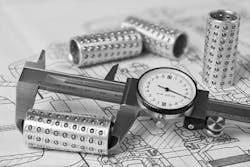This article was updated on June 18, 2025. It was orginally published Nov. 15, 2002.
Proper installation and maintenance are essential to bearing performance and premature failure prevention due to misalignment, contamination or inadequate lubrication.
When selecting linear bearings, design engineers are reminded to also consider the following attributes to increase reliability and efficiency:
Load capacity. Hardness, finish and conformity of race and rolling elements influence load capacity. Increased hardness—typically measured using Brinell or Rockwell scales—enhances resistance to plastic deformation and increases load capacity. The surface finish must be smooth because grinding marks create ridges that prevent conformity between the race and rolling element.
With a flat raceway, ball bearings have a lower load capacity compared to roller bearings and large-diameter ball bearings are required to achieve the same load rating. When the raceway is ground with either a Gothic arch or a circular groove profile, the improved conformity between the ball and the raceway allows the use of smaller balls while maintaining similar load capacity.
The Gothic arch profile functions similarly to a V-type way, splitting the load into two contact points at approximately 45-deg. angles from the vertical. This enhances load distribution and rigidity. The circular groove has a higher load capacity, but the ball bears on the bottom of the groove, which results in side (lateral) play when loads are applied perpendicular to the direction of motion.
READ MORE: How “Smart” Components are Getting Smarter: Valves, Bearings, Gearboxes and Brakes
Preloading. All rolling-element linear-motion bearings have some deflection between raceways and rolling elements under load. This deflection can be minimized by applying a preload, which is an intentional internal load that eliminates clearance and increases stiffness.
However, this requires greater bearing precision and meticulous installation to avoid misalignment and stress. Preloading also increases frictional resistance (drag torque). This can be a disadvantage in servomechanisms, where higher drag may require a larger, more powerful motor to maintain responsiveness.
When the operating speed approaches one of bearing system’s natural frequencies, vibrations may develop. Since rolling element bearings inherently have low damping, vibrations can persist. In this instance, a properly applied preload can improve dynamic stiffness—provided that the additional drag is acceptable for the application.
Life ratings. Manufacturers typically provide life ratings for linear motion bearings based on statistical fatigue life data originally developed for ball bearings. These ratings are a baseline and do not accurately predict real-world scenarios, where factors like contamination, misalignment and mounting precision can affect performance.
For example, recirculating flat-way roller bearings may sometimes fail due to skewing or misalignment rather than classical fatigue. Recirculating roller bearings, in contrast, often fail from rolling contact fatigue and, when operated within their rated load limits and under proper installation conditions, can have a longer service life compared to other types of linear motion bearings.
READ MORE: The Evolution of Bearing Solutions in Humanoid Robots
Cleanliness. As with any type of bearing, preventing ingress of contaminants such as metal chips, grit, plastic dust, fibers or other airborne particles is crucial. Hard chips in the path of the rolling elements cause spalling or fracturing and can damage the raceways.
Any dirt or grit between race and rolling elements leads to wear, which results in progressive surface degradation and increased internal clearance (play). Plastic dust and fibers are particularly problematic in recirculating bearings. These materials tend to accumulate in the recirculation paths, eventually obstructing movement and impairing bearing performance.
To maintain bearing integrity, physical barriers should be employed to exclude contaminants. Bellows-type enclosures are highly effective in protecting critical components from debris. Telescoping tubes or cover plates can also serve as robust protective solutions in high-duty environments.
Some linear motion bearings are equipped with integral rubber-lip seals that eliminate the need for extended housings (to accommodate outboard seals) or external seals. These integrated seals simplify installation and reduce the risk of seal displacement.
For round-shaft bearing systems, a clock-spring cover can be used—where the inner coil is attached to the end of the shaft and the outer coil is attached to the outer diameter (OD) of the bearing. Some machine tool installations use a window-shade style way cover that’s made of heavy rubber or synthetic material. This material is stored on a roller mechanism at either end of the machine bed and extends to protect the travel zone during operation.
If none of these methods are feasible, wipers or scrapers should be used. These are readily available for both flat or round guideways and are usually made of felt, leather or engineered plastics. Some designs incorporate spring-loaded fingers for positive sealing.
Custom enclosures are often required for ball spline bearings. These are generally more effective at excluding large chips than fine dust and should be selected based on the expected contaminant type and operating environment.
Lubrication. For low-friction operation, a thin film of oil keeps surfaces lubricated. The oil also inhibits rust, which causes problems. If the atmosphere is particularly corrosive, stainless steel or some other special alloy must be used as the bearing material. Surface coating and plating have come a long way; coatings such as chrome plating, black oxide or advanced polymer coatings) are now commonly used for their corrosion resistance and wear properties—especially when stainless steel is not feasible.
